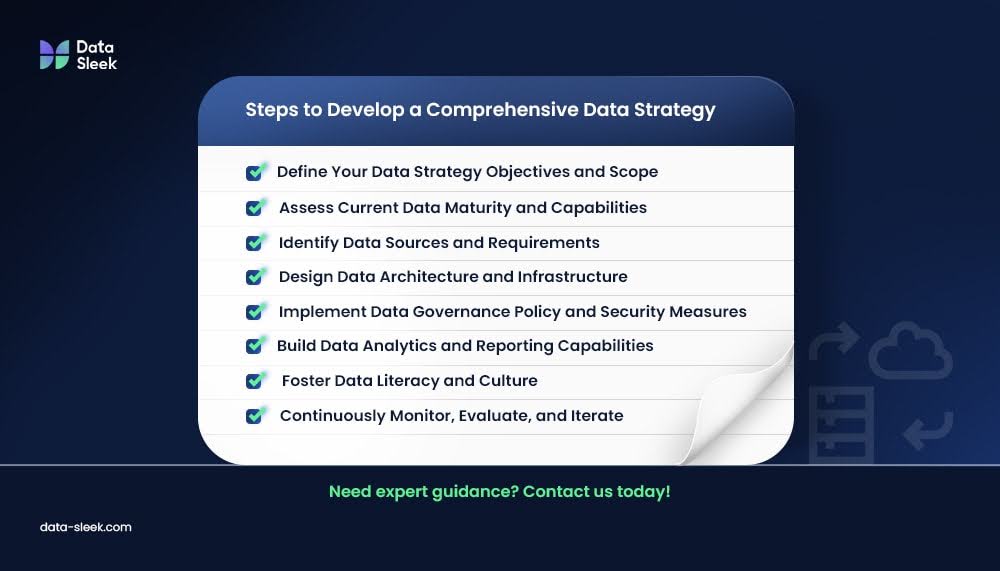For many companies striving to gain and maintain a competitive edge, a clear-cut data strategy is all that’s keeping them from reaching the next level of success.
Imagine you’re heading out on a business trip. You would only close the door behind you with a clear plan of where you’re going and what you’ll be doing when you get there, right? The same applies to running a successful business in today’s data-driven world. Without an effective data strategy roadmap, you’re essentially traveling blind.
A robust data strategy guides you through a sea of data and ensures you’re making informed decisions, boosting operational efficiency, and staying ahead of the competition. In this guide, we’ll explain everything you need to know about creating a data strategy that delivers results.
What is a Data Strategy?

A data strategy is a comprehensive plan that outlines how an organization will use its data. It aligns data initiatives with business goals, ensuring your data delivers the maximum ROI.
Effective data strategies help you harness the power of your data to streamline operations and uncover new opportunities. It involves components like setting clear objectives and maintaining data governance. You can read more about what a data strategy is in one of our latest blogs.
Who Needs a Data Strategy?
Every organization benefits from a data strategy regardless of size or industry. Whether you’re a retail giant or a small healthcare provider, the insights gained from data can transform your operations and drive success.
Consider the following use cases:
- Retail Companies: Data strategies might include analyzing purchase histories, browsing behavior, and demographic information. Retailers can tailor their marketing campaigns and product recommendations to hyper-personalize customer experience.
- Healthcare Providers: Data strategies might include electronic health record (EHR) integration, patient feedback, and treatment data. Healthcare providers can use this data to improve patient outcomes and reduce operational costs.
- Manufacturers: Data strategies might include monitoring equipment performance, supply chain data, and production metrics. Using real-time data insights, manufacturers can optimize production processes to enhance production quality and reduce downtime.
These scenarios aren’t just theoretical–businesses across the globe are already using data strategies to achieve remarkable results. Companies like Netflix analyze every stage of browsing behavior, from trends in film preferences to the effectiveness of promotional artwork. Based on collective insights from user data, over 80% of the TV shows and movies that Netflix members watch are a result of Netflix’s personalization algorithms.
Similarly, the German soccer league, Bundesliga, uses data-driven insights for talent recruitment and storytelling. Using data analysis to evaluate potential talent prospects led to recruiting star players like Can Uzun, Jannis Nikolaou, and Matthias Zimmerman. Data insights for storytelling add a deeper dimension to the fan experience.

Implementing a robust data strategy offers numerous benefits to organizations of all sizes. Some of these benefits include, but are not limited to:
- Enhanced Decision-Making Capabilities: Make informed decisions based on solid data insights
- Increased Operational Efficiency: Streamline data processes and eliminate redundancies.
- Better Customer Insights and Experiences: Understand your customers better and tailor your offerings to meet their needs.
- Competitive Advantage Through Data-Driven Innovation: Stay ahead of the competition by leveraging innovative data solutions.
- Potential for New Revenue Streams: Discover new ways to generate revenue based on metrics like user behavior, preferences, and trends over time.
- Improved Data Governance and Quality: Ensure your data is accurate, consistent, and reliable.
- Compliance with Data Regulations and Standards: Ensure your data practices meet legal and regulatory requirements.
Consider the facts: A Gartner study revealed that poor data quality costs businesses an average of 12% of their annual revenue. Mckinsey reports that 71% of consumers expect companies to deliver hyper-personalized interactions. Of those consumers, 76% get frustrated when this doesn’t happen. Implementing an effective data strategy addresses these issues.
Common Problems Data Strategies Solve
Even the slightest strategic data push can benefit a business–having some form of plan in place is better than nothing at all. However, a comprehensive data strategy addresses several critical issues. Some of these issues include, but are not limited to:
- Data Silos and Lack of Integration: break down barriers and ensure seamless data flow across the organization’s disparate data sources and multiple business units.
- Inconsistent Data Quality and Integrity: Maintain high data accuracy and reliability standards.
- Inefficient Data Management Processes: Optimize data collection, storage, and use.
- Limited Data-Driven Decision-Making Capabilities: Empower your team with the necessary insights for strategic decisions.
- Compliance and Security Risks: Protect your data and stay compliant with regulations.
- Inability to Leverage Data Assets Effectively: Maximize the value derived from your data.
Consider the facts: Boeing, an aviation giant and global manufacturing company, integrated its data silos and saw a 20% improvement in operational efficiency.
Key Components of a Successful Data Strategy
A successful data strategy looks different depending on your business goals. Generally, effective data strategies contain components such as data governance rules, data architecture, analytics and insights, data literacy and culture, and data security and privacy.
Data Governance
Data governance is the foundation of a successful data strategy. It involves setting clear policies and procedures to ensure data quality, integrity, security, and compliance. Start by defining roles and responsibilities for data management across your organization. Establish data standards and guidelines for data entry, processing, and storage to maintain consistency. Regular audits and updates to these policies are crucial to adapt to changing regulatory requirements and business needs.
Data Architecture
A well-designed data architecture is essential for efficient data flow and integration. Such involves creating a blueprint for collection, data storage, and accessing high-quality data. Your architecture should be scalable and flexible to accommodate growing data volumes and evolving business requirements. Use technologies that support data warehousing, data lakes, dimensional modeling transformation, and real-time data processing. Companies like Amazon and Google exemplify robust data architectures that efficiently handle vast amounts of data, enabling seamless data operations.
Data Analytics and Insights
Data analytics transforms raw data into actionable insights. Equip your team with powerful tools like Tableau, Power BI, SAS, and SPSS to analyze and visualize business data effectively. Develop an analytics framework that includes descriptive, predictive, and prescriptive analytics to cover various decision-making scenarios. By leveraging these insights, your organization can identify trends, forecast outcomes, and make informed strategic decisions, ultimately driving business value, growth, and innovation.
Data Literacy and Culture
Building a data-literate workforce is crucial for embedding data-driven decision-making into your organization’s culture. Offer continuous learning opportunities such as workshops, online courses, and hands-on training sessions. Encourage employees to develop data skills relevant to their roles. Promote a culture where data is seen as valuable and integrates into everyday decision-making processes. This cultural shift ensures that all levels of the organization can effectively harness data’s power.
Data Security and Privacy
Data security and privacy are paramount in protecting your data assets and maintaining customer trust. Implement robust security measures, including encryption, access controls, and regular security audits. Ensure compliance with relevant data protection regulations such as GDPR and CCPA. Develop data access, usage, and sharing protocols to prevent unauthorized access and data breaches. Emphasize the importance of data privacy through training and awareness programs, reinforcing your commitment to safeguarding sensitive information.
Remember, your data strategy will differ based on your organization’s unique needs and business objectives. Your existing data architecture will determine which organizational processes to prioritize and which ones to shelf for later. Consider the different aspects of data management and adjust your data strategy plan accordingly.

Steps to Develop a Comprehensive Data Strategy
1. Define Your Data Strategy Objectives and Scope
Start by setting clear, measurable goals that align with your business objectives. This ensures your data strategy is focused and purpose-driven. An e-commerce company might aim to increase customer retention by 15% YoY using personalized marketing strategies derived from data insights.
2. Assess Current Data Maturity and Capabilities
Evaluate your existing data assets, technologies, and business processes. Understand where you stand and identify areas for improvement. A healthcare provider might audit their current EHR systems to identify data collection and integration gaps.
3. Identify Data Sources and Requirements
Determine the specific data you need to achieve your goals. Identify the sources and outline your data requirements. A financial services firm might identify the need for real-time transaction data to improve fraud detection systems and other business processes.
4. Design Data Architecture and Infrastructure
Build a scalable, flexible, and secure data infrastructure. Your infrastructure should meet business objectives in the short term and can grow with your business in the long run. Tech companies might develop a data lake as part of their enterprise data strategy to handle large volumes of diverse data types, ensuring future scalability.
5. Implement Data Governance Policy and Security Measures
Establish policies to ensure data quality, security, and compliance. Clear data governance policies help maintain data integrity and trust. A multinational corporation bolsters security in its data strategy by implementing GDPR compliance measures to protect customer data in Europe.
6. Build Data Analytics and Reporting Capabilities
Develop tools and processes for practical data analysis and visualization. Business intelligence tools transform data into actionable insights. A retail chain’s data strategy might use Tableau for sales data visualization to measure progress and act on emerging market trends.
7. Foster Data Literacy and Culture
Train employees and promote a data-driven organization. Encourage continuous learning and data usage. An essential part of a manufacturing firm’s data strategy might include offering data literacy workshops to help staff use analytics tools effectively in production planning.
8. Continuously Monitor, Evaluate, and Iterate
Regularly review and refine your data strategy. Use feedback and performance metrics to make necessary adjustments and improvements. Consistent data management is key. A large retail chain, for example, might use customer feedback and sales metrics to continuously improve its personalized marketing campaigns. The target metrics might be a 50% improvement in customer satisfaction and a 20% increase in sales within a year.
Best Practices and Common Pitfalls to Avoid in Developing Your Business Strategy
Creating a data strategy is crucial. However, a data strategy is only as effective as its implementation. Aligning data initiatives with business goals while prioritizing data quality, fostering collaboration, and maintaining agility are key practices that ensure your strategy delivers value across your entire organization.
Conversely, lacking clear objectives, underestimating integration complexity, and other pitfalls can derail your efforts. Here, we’ve outlined some of the best practices for a successful data strategy implementation. We’ve also outlined some common pitfalls to watch out for in your data strategy roadmap.
Best Practices for Implementation
- Align Data Initiatives with Business Goals: Ensure your data strategy supports and drives your business objectives. This alignment ensures that data initiatives are purposeful and impactful.
- Prioritize Data Quality and Governance: Maintain high data quality and governance standards to ensure data reliability and trustworthiness.
- Foster Collaboration Between IT and Business Units: Encourage close collaboration between your chief data officer, business leaders, IT teams, data users, and business units to ensure solutions meet business needs.
- Stay Agile and Adaptable: Be prepared to adapt your data strategy as business needs and technologies evolve.
- Invest in Data Security: Protect your data assets with robust security measures to prevent breaches and ensure compliance with regulations.
Common Pitfalls to Avoid
- Lack of Clear Objectives: Without clear business goals, your data strategy can become unfocused and ineffective.
- Underestimating the Complexity of Data Integration: Data integration can be complex and challenging; underestimating this can lead to significant setbacks.
- Neglecting Data Quality: Poor data quality undermines the reliability of your insights and decision-making.
- Failing to Foster A Data-Driven Culture: Employees may resist using data in their decision-making processes without a data-driven culture.
- Ignoring Data Security and Compliance Risks: Neglecting security and compliance can result in data breaches and legal issues.
Do You Need a Data Strategy Plan? Weighing the Value of A Data Management Professional
Developing a robust data strategy is complex and demands specialized expertise. Professional data management consultants (like us!) bring several key advantages to the table:
Industry Best Practices: We use proven methods that have been successful across various industries. Best practices ensure your data strategy’s foundation is grounded in reliability and efficiency. When crafting a data strategy, you want to ensure you invest the time and resources into the right solution.
Deep Technical Knowledge: With expertise in the latest tools and technologies, our consultants can design and implement state-of-the-art data solutions tailored to your specific needs. This technical proficiency ensures that your data infrastructure is both cutting-edge and scalable. We work with major partners to ensure your data strategy enables your organization to maximize ROI while future-proofing your business.
Objective Assessment: An external consultant objectively evaluates maturity and capabilities. This objective view helps identify your organization’s unique strengths, weaknesses, and opportunities that might be overlooked internally.
Navigating challenges: Our experienced consultants have a track record of overcoming common pitfalls and obstacles. We’re well-versed in spotting the hidden potential and silent killers of an organization’s data. As a result, we’re also well-versed in devising strategies to mitigate risks and ensure a smoother implementation process.
Need more convincing? We’ve helped many companies like yours build a customized data strategy that drives results.
Learn more about our data strategy services here.
Taking the Next Steps in Crafting Your Data Strategy
Developing a comprehensive data strategy can seem like a daunting task. However, with the right approach, it will be a powerful addition to your overall business strategy. Start by defining clear objectives and assessing your current data maturity. Leverage industry best practices and incorporate governance and security measures to mitigate risks.
Still trying to figure out where to start? Consider partnering with our expert data strategy consultants to help you navigate the complexities of your data journey. Remember, the goal is to build a strategy that meets today’s needs and scales with your business growth.Ready to transform your business with a powerful data strategy? Don’t wait–contact us today to turn your data into a strategic asset that drives innovation and efficiency. Let’s unlock your data’s full potential and propel your business forward by starting with a free consultation. Schedule this risk-free consultation with one of our data management experts today!







